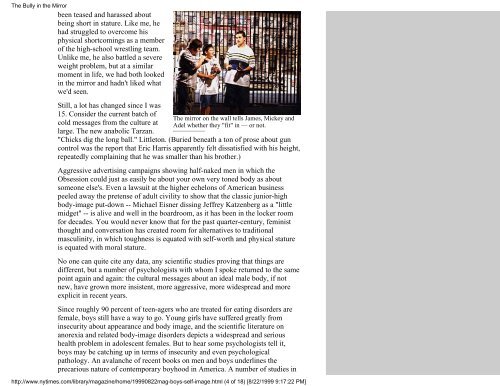The New York Times Magazine, Sunday, August 22 - Unauthorized ...
The New York Times Magazine, Sunday, August 22 - Unauthorized ...
The New York Times Magazine, Sunday, August 22 - Unauthorized ...
You also want an ePaper? Increase the reach of your titles
YUMPU automatically turns print PDFs into web optimized ePapers that Google loves.
<strong>The</strong> Bully in the Mirror<br />
been teased and harassed about<br />
being short in stature. Like me, he<br />
had struggled to overcome his<br />
physical shortcomings as a member<br />
of the high-school wrestling team.<br />
Unlike me, he also battled a severe<br />
weight problem, but at a similar<br />
moment in life, we had both looked<br />
in the mirror and hadn't liked what<br />
we'd seen.<br />
Still, a lot has changed since I was<br />
15. Consider the current batch of<br />
cold messages from the culture at<br />
large. <strong>The</strong> new anabolic Tarzan.<br />
<strong>The</strong> mirror on the wall tells James, Mickey and<br />
Adel whether they "fit" in — or not.<br />
"Chicks dig the long ball." Littleton. (Buried beneath a ton of prose about gun<br />
control was the report that Eric Harris apparently felt dissatisfied with his height,<br />
repeatedly complaining that he was smaller than his brother.)<br />
Aggressive advertising campaigns showing half-naked men in which the<br />
Obsession could just as easily be about your own very toned body as about<br />
someone else's. Even a lawsuit at the higher echelons of American business<br />
peeled away the pretense of adult civility to show that the classic junior-high<br />
body-image put-down -- Michael Eisner dissing Jeffrey Katzenberg as a "little<br />
midget" -- is alive and well in the boardroom, as it has been in the locker room<br />
for decades. You would never know that for the past quarter-century, feminist<br />
thought and conversation has created room for alternatives to traditional<br />
masculinity, in which toughness is equated with self-worth and physical stature<br />
is equated with moral stature.<br />
No one can quite cite any data, any scientific studies proving that things are<br />
different, but a number of psychologists with whom I spoke returned to the same<br />
point again and again: the cultural messages about an ideal male body, if not<br />
new, have grown more insistent, more aggressive, more widespread and more<br />
explicit in recent years.<br />
Since roughly 90 percent of teen-agers who are treated for eating disorders are<br />
female, boys still have a way to go. Young girls have suffered greatly from<br />
insecurity about appearance and body image, and the scientific literature on<br />
anorexia and related body-image disorders depicts a widespread and serious<br />
health problem in adolescent females. But to hear some psychologists tell it,<br />
boys may be catching up in terms of insecurity and even psychological<br />
pathology. An avalanche of recent books on men and boys underlines the<br />
precarious nature of contemporary boyhood in America. A number of studies in<br />
http://www.nytimes.com/library/magazine/home/199908<strong>22</strong>mag-boys-self-image.html (4 of 18) [8/<strong>22</strong>/1999 9:17:<strong>22</strong> PM]






